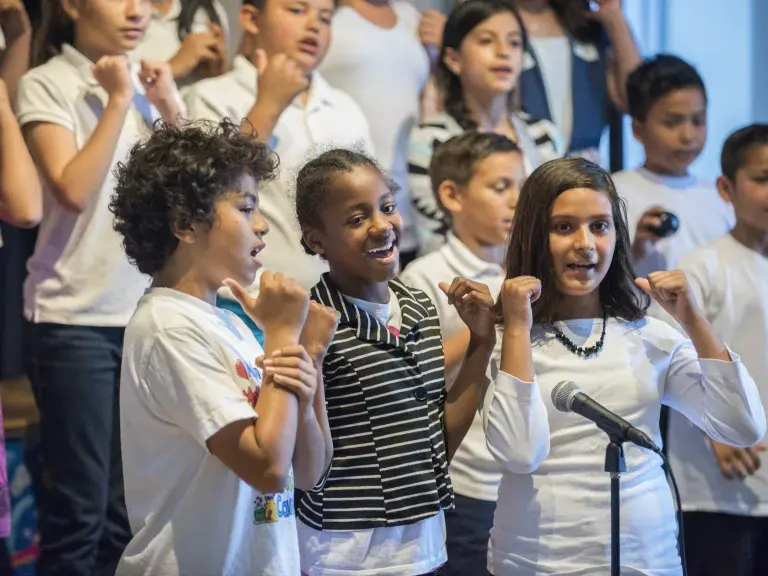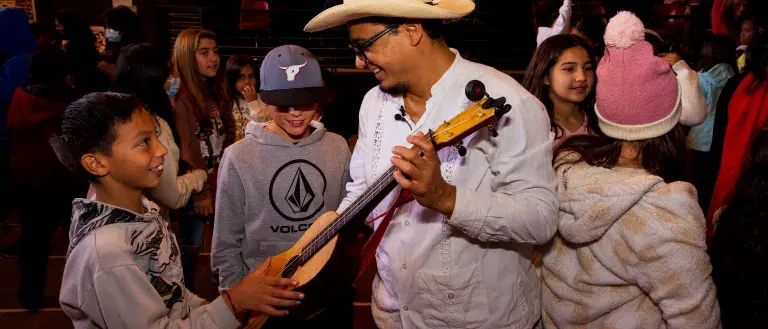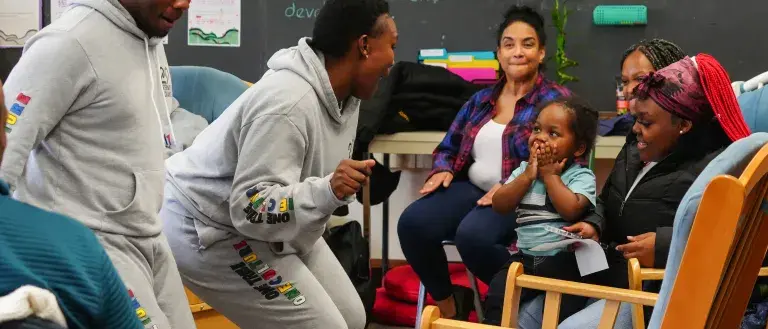Building Community and Sustaining Relationships
Many grantee organizations centered community values and building community relationships in their project design. These are key priorities for Tucson Girls’ Chorus (TGC) and the Engagement Choirs program, which encompasses TGC’s work in Title 1 schools and community organizations across the Tucson, Arizona community. Through this program, TGC began a relationship with the Tohono O’odham Nation, located approximately three hours away from Tucson, in 2021. The program serves students ranging from kindergarteners through eighth grade and includes some high school students who serve as facilitators. Teaching artist Nicky Manlove works with students once a week over Zoom, video calling in to a community center where the students gather. Despite challenges such as technology acting up and students’ limited access to resources including transportation to get to and from the center, this partnership has been a meaningful one and the students look forward to the weekly sessions.
TGC has been careful not to impose Western European-style classical musical training methods on the students. Instead, Manlove focuses on music-making and learning that is in line with students’ community and culture, in which, Manlove said, “music is an important form of knowledge production and memory.” Manlove makes the sessions as interactive as possible, relying heavily on the adults and high schoolers present at the community center to help facilitate. Since Manlove’s communication with the students is virtual, the facilitators repeat instructions and demonstrate as well. “It’s been really rewarding for me to see these teachers who are in the community and have deep relationships with these singers and their families, who are also encouraging them to sing and to move—not as gimmicky things, but as a means of building community and building memory together and sharing and culture,” said Manlove. The facilitators also help build the children’s confidence, said TGC artistic and executive director Marcela Molina. “These kids sometimes are so shy, they need somebody that looks like them, just doing it, you know. So that makes a big difference.”
Surry Arts Council, based in North Carolina, used the Music Education Partnership Grant money to create opportunities for students from three different schools to sing together. This project incorporated a variety of non-musical bonding activities that allowed the students to feel comfortable with each other.
“First month we met up, I couldn't get them to talk. They were super shy,” said Surrey Arts Council artistic director Tyler Matanick. “So the first month, we didn't even sing—we did some icebreaker games, we had snacks, we got to know each other. I think we sang for like five minutes, actually. We warmed up just to see what we would sound like to each other.” The students’ level of comfort progressed as they had more interactions. “By the next month that we met, they came in like they've been best friends for years,” said Matanick. “And then the third month … we took them over to our movie theater and showed them a free movie. It was more of a bonding experience. And then this last month, we were singing the whole time up on the risers. So they're finally working with each other, singing with each other.” The strategy of incorporating a range of activities into the project got students comfortable with each other, enhancing the entire singing experience.
Building Intergenerational Connections
Studies report many benefits to intergenerational singing. A 2016 study, Why Multimodal Literacy Matters, found that it provides a way to build and strengthen bonds with one’s family and participate in meaning-making and identity building between generations, allowing a unique form of intimacy. Many of the 2022-23 grantee organizations incorporated intergenerational singing into their projects to help strengthen bonds within families.
Minneapolis-based choral organization VocalEssence has had an ongoing relationship with Longfellow High School, a school for pregnant or parenting teen students. VocalEssence’s associate artistic director G. Phillip Shoultz, III, holds weekly sessions at the school, working with students to build bonds with their babies through music as well as building their own confidence. He has tried a range of strategies to make the students feel more comfortable opening up and singing, including involving them in choosing the repertoire, using call and response techniques, and promising to bring them ice cream if they could “outsing” him. “I knew in my heart, many of them are singers,” Shoultz said. “It's just finding a way in to get them to sing in a group setting and to be comfortable with that self-expression.”
Because so many of the students are bilingual, the repertoire they learn is a mix of English and Spanish songs. Since Shoultz’s Spanish skills are basic, he hired a student to be a translator for him. He noted the importance of building relationships with the students, and how he observed a change in their comfort with singing after a few sessions.
Shoultz initially spends an hour with the entire group, followed by two hours with two different parenting classes doing intergenerational singing and teaching children’s songs and how to move with their babies. In addition to supporting bonds between parents and children, the program has also created opportunities for teachers and students to form new connections that also span generations. Shoultz noted that teachers at the school who are free during sessions come and sing with the students. “It's helping the students to see their teachers in a different light,” he said. “But the teachers are learners too. And the end game is that all of us are going to sing together at graduation.”
Bluefield Arts & Revitalization Corporation in Bluefield, West Virginia, has also taken on an intergenerational singing project, although in a very different way. This organization worked with schools in Mercer County, a rural area with few music opportunities, to provide free after-school singing opportunities to students and their guardians. Brian Tracey who headed this program noted that participation increased during the program year and that some of the families enjoyed the experience so much they asked when they would have the opportunity to perform in public. He reported that a fifth grader who sang with her uncle said that she liked the Music Across the Years program because “I just wanted a chance to sing and make peaceful sounds with others.”
Building Community through Cultural Learning
Learning music involves learning about cultural expression, history, and so much more. Many grantee organizations were very intentional about selecting music for their projects that represented an array of cultures and communities so that students would learn about cultures that they would not normally have the opportunity to learn about and would see themselves represented in the music they were learning from traditions beyond mainstream Western choral music. As one survey respondent said “by learning about diverse cultures, students learn about how others live. Their worlds become bigger as they learn about how large our world is. This is very important in building respect and empathy.” Cultural learning helps build stronger communities.
McAuliffe Elementary School in Oceanside, California partnered with hula teacher and kanaka maoli (Native Hawaiian) Ilima Kam Martinez to bring the students an experience that taught them about Hawaiian culture through music, dance, and language. The children learned the art of hula, how to play a range of instruments including the ukulele, and Hawaiian words. Assistant principal Christine Corrao said that the teaching artist used a lot of Hawaiian language. “She's taught them in a call and response format. So she'll tell them to turn around, or to stand up or sit down, and she only uses those Hawaiian commands in order to do it. So there's actually a lot of language learning that's taking place too which I think is awesome.” The students loved this approach and parents reported that they were often very excited to show off what they had learned. One parent expressed that their children demonstrated an impressive amount of knowledge about Hawaiian culture and language on a family vacation to Hawai’i.
Grand Vision Foundation provides a program called Roots of Music to fourth graders in the Los Angeles Harbor area, introducing children to a range of musical styles and exploring the history and cultures from which those styles come. They worked with 20 schools during the 2022-23 year, eight of which are supported by Chorus America funding, and reached a large number of students. This program is comprised of three units, each three weeks long: African drumming and singing and African American spirituals, bluegrass and early Americana folk music, and son jarocho, a regional music tradition from the Mexican state of Veracruz. The students are introduced to the musical concepts, shown videos of the group/artist they will be seeing later, and are encouraged to ask questions of and interact with the teaching artist for each unit. Education manager Sukari Reid-Glenn reported that the teachers had noticed the students’ confidence growing as they progressed through the sessions and that students were very supportive of each other in performances and other sessions.
Augusta Heritage Center in Elkins, West Virginia worked with their partner schools to bring in guest artists to conduct assemblies at the schools. Guest artists for this program included Suzannah Park, an Appalachian ballad singer, Sandra Santos Canizares, a Cuban singing artist, Dr. Kathy Bullock, an expert in gospel music and spirituals, and Nadia Tarnawsky, a Ukrainian singing artist. Ko Cha’ Ta “Seth” Young, the executive director of the Augusta Heritage Center, said that when Bullock visited the schools “it might have been the first time that one of our Black students here in this county has seen a mentor that looked like them, that shared their story, so the inclusivity and the cultural exchange has just been very impactful. And it's not something that is on paper; it's tangible, and real, and authentic.” Bullock also taught the students about the history of slavery and coded language in spirituals when teaching them songs such as “This Little Light of Mine.”
Young reported that students responded very enthusiastically to learning songs in other languages. Sandra Santos Canizares taught the children a chant that children in Cuba used to pick others to be ‘it’ in a game of tag, using a common childhood reference to connect with the children and participate in another cultural and musical moment of play.
Group singing builds community, helps people learn about other cultures and learn about history, and much more. The work these Music Education Partnership Grants grantee organizations did in 2022-23 demonstrates that, while there is no one right way to incorporate these different elements into students’ musical experiences, it is important to make choral experience about more than just the singing. Group singing also allows young people to experience, learn about, and appreciate more of the cultures present in the world they inhabit.
Ayesha Casie Chetty, PhD, is a mixed-methods social scientist with over ten years of research experience. She is currently a research and evaluation associate at DCG Communications and a freelance research consultant.




